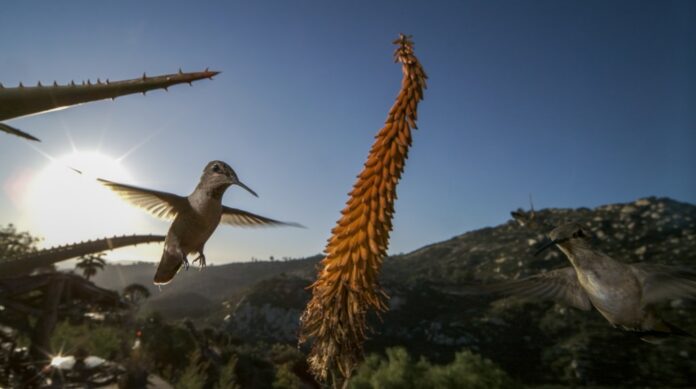Ask any San Diegan the city’s motto and they’ll say it’s “America’s Finest City.” But what most San Diegans might not know is that it’s also America’s wildest city.
Thanks to its unique geographical intersection of ocean, mountains, deserts, wetlands and urban development, San Diego County is recognized as the most biologically diverse county in the continental United States, according to the Nature Conservancy.
That’s the subject of “Nature — San Diego: America’s Wildest City,” which premieres at 8 p.m. Wednesday on PBS stations and the PBS app. A giant-screen version of the film, titled “Wild San Diego,” will follow on Nov. 22 for a seven-year engagement at the San Diego Natural History Museum.
“San Diego: America’s Wildest City” was written by Nate Dappen and Neil Losin, co-owners of San Diego-based Day’s Edge Productions, which co-produced the 52-minute film with WNET Group and Terra Mater Studios.
Past Day’s Edge film projects include the six-part PBS Science documentary series “Human Footprint” (2023), “Serengeti: Nature’s Living Laboratory” (2019); and the Inland Passage paddling adventure doc “The Passage” (2019), among many others.
Dappen said he, Losin and their production team have been working on the “Wildest City” project for the past two years. It’s about how wildlife in San Diego has adapted and survived in a landscape that has been dramatically transformed over time by humans and the challenges and opportunities these species face today.
“The first day I arrived in San Diego and walked to the beach at sunset, I looked out at the ocean and listened to the sound of surf, seagulls, and seals and knew this wonderful place would become my home,” Dappen said. “What I didn’t realize on that day was just how rich this landscape was. I began to explore and was stunned by the diversity of ecosystems here — deserts, mountains, chaparral, and the great Pacific Ocean all within an hour drive. I knew I wanted to create a film that celebrates a different, spectacular side of America’s most biodiverse county.”

The film looks at a handful of wildlife species that are not only native to San Diego County but that also have either adapted to, or been hurt by, the presence of humans, who arrived in this region 12,000 years ago and have increased 500-fold in number to 3.3 million over the past 100 years. The greatest influence humans have had on wildlife, the documentary says, is how we manage our water resources.
Among the many species observed in the documentary are Western grebes, red-eyed water fowl that nest in man-made reservoirs and lakes. There’s also the Allen’s hummingbird, which now comfortably nest in urban backyards, where they can gather nectar from nurtured gardens and sip from sugar water-filled hummingbird feeders. There are the Pacific harbor seals, who take over the human-made 1931-era Children’s Pool in La Jolla each year as a pupping ground.
Common ground squirrels have happily moved their burrows from open fields to public parks, which are abundantly stocked with irrigated grass, plants, trees and water. And desert birds, bobcats and coyotes increasingly rely on humans’ backyard swimming pools, ponds and fountains as water and bathing sources.
There are also segments in the film on some of the regions’ natural wonders, like grunion, the silvery fish that spawn on local beaches during spring high tides; the bioluminescent blue tides caused by single-cell algae known as dinoflagellates; and wildflower superblooms in the Anza-Borrego desert.

The documentary doesn’t delve deep into the threat that development, drought and climate change pose to local plants and wildlife, but it does show some of the unexpected results.
For example, the city of San Diego recently stopped using automated sand grooming machines on its beaches during grunion season because the heavy machines were crushing millions of eggs laid under the sand. It also shows how when heavy rains force water officials to open the floodgates of dams, the grebe nests upstream are often destroyed. It explains that crows didn’t exist in San Diego until the 1980s, but were drawn to the region as a fertile hunting ground for thriving bird, squirrel and other prey. And it shows how the massive border fence that separates the U.S. from Mexico has cut off roaming species like deer and coyotes from previous water sources.
Dappen and Losin met in 2008 in Costa Rica, where they were both doing field work for their doctorates. After discovering they shared a passion for nature photography and film, they abandoned their plans for academics career in 2010 and started Day’s Edge, which has produced educational and advocacy films about nature, wildlife, agriculture, anthropology and the environment.
Originally Published:



